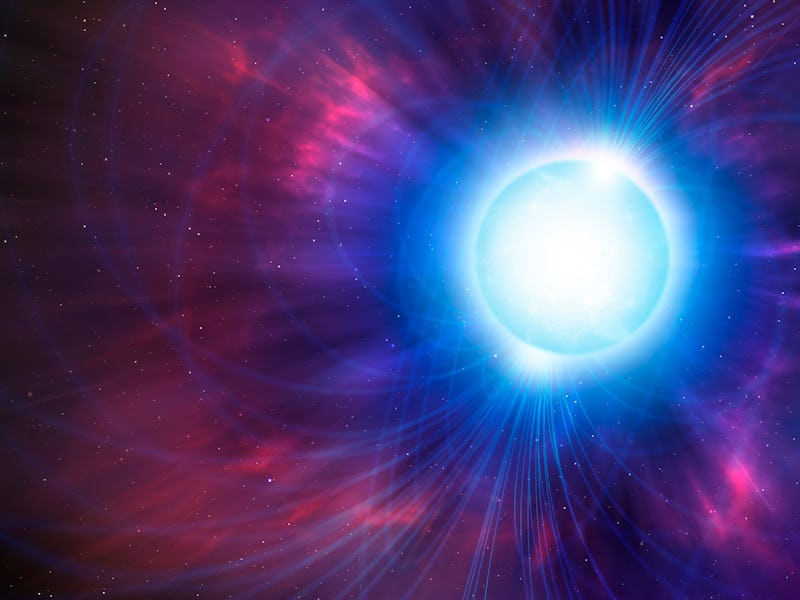In Space, The Dead Scream — Now, Scientists Are Finally Listening
Most fast radio bursts are one-off events that never seem to repeat, but a recent study suggests astronomers just need to be patient.

In space, the dead sometimes speak — and sometimes they scream.
Massive stars end their short, blazing lives in tremendous stellar explosions called supernovae, and they sometimes leave behind dense, highly magnetized balls of neutrons called magnetars. And for reasons that astronomers don’t yet fully understand, sometimes a magnetar lets out a short but powerful shriek. Astronomers call these Fast Radio Bursts, or FRBs: very intense blasts of radio waves that last just a few milliseconds.
Astronomers have observed thousands of these strange radio signals over the last few years, and most of them seem to be one-off events: a brief burst of radio waves from a dead star, and the rest is silence. Only a small, fascinating handful of FRBs actually repeat, or so it seems. In a recent study, a team of astronomers led by McGill University astronomer Bridget Andersen suggest that many more FRBs — maybe even all of them — may repeat, if only we would listen long enough.
They published their results in The Astrophysical Journal.
CHIME’s oddly-shaped antennas can scan the whole northern sky once a day.
Hidden in the Data
Andersen and her colleagues recently combed through years of data from the Canadian Hydrogen Intensity Mapping Experiment, or CHIME, a radio telescope in British Columbia that scans the entire northern sky every day. They were searching for repeating FRBs that might have gotten buried in the data because their signals arrived so far apart that they escaped astronomers’ attention. To find them, Andersen and her colleagues looked for signals from the same part of the sky, even if they were far apart in time, using new statistical methods to help work out whether they were seeing a repeating FRB or just two unrelated FRBs that happened to come from the same direction.
“We can now accurately calculate the probability that two or more bursts coming from similar locations are not just a coincidence,” says co-author Ziggy Pleunis, an astronomer at the University of Toronto.
The astronomers identified 25 repeating FRBs in the CHIME data. That means that astronomers have now heard at least 50 FRBs repeat their chilling cries — that’s out of the thousands that have been recorded so far. But Andersen and her colleagues say we may just need to listen longer.
Solving An Astronomical Puzzle
Computer artwork showing the magnetic field (lines) around a magnetar. A magnetar is a type of neutron star with an incredibly strong magnetic field (a million billion times stronger than that of the Earth), which is formed when certain stars undergo supernova explosions.
Astronomers have detected thousands of FRBs in recent years, but that doesn’t add up to knowing much about them. So far, fewer than sixty FRBs have been traced back to their host galaxies, and thirty of those were only announced earlier this year. (Nearly all FRBs come from galaxies far, far away; astronomers have only ever detected one inside our own Milky Way.) And while it’s generally agreed that FRBs come from magnetars, the exact mechanics behind them remain a puzzle waiting to be solved. Some FRBs may come from different sources, too, according to the team that traced thirty of them to their host galaxies back in January.
And whether or not those signals repeat could offer a clue. So far, the small number of FRBs that repeat seem to have a different length and cover a different range of radio frequencies than the one-off FRBs. That leads some astronomers to suggest that repeaters and one-offs might actually be two different types of FRBs, with two different explanations.
Andersen and her colleagues now have a different idea.
“Many apparently one-off bursts have simply not yet been observed long enough for a second burst from the source to be detected,” says Pleunis.
Some of the repeating FRBs they found buried in CHIME data held their silence for a long time between repeats, crying out less than once in every week of observing time. That means that unless astronomers are willing to keep listening to the same patch of sky for days or weeks at a time — a risky gamble in a field where telescope time is in high demand — a repeating burst might end up looking like a one-off. It’s even possible that all FRBs may repeat… eventually.
Differences in radio frequency and the length of the signal may still point to more than one origin for these weird cosmic signals, though. When it comes to FRBs, questions still abound, and astronomers can only answer them with more data.